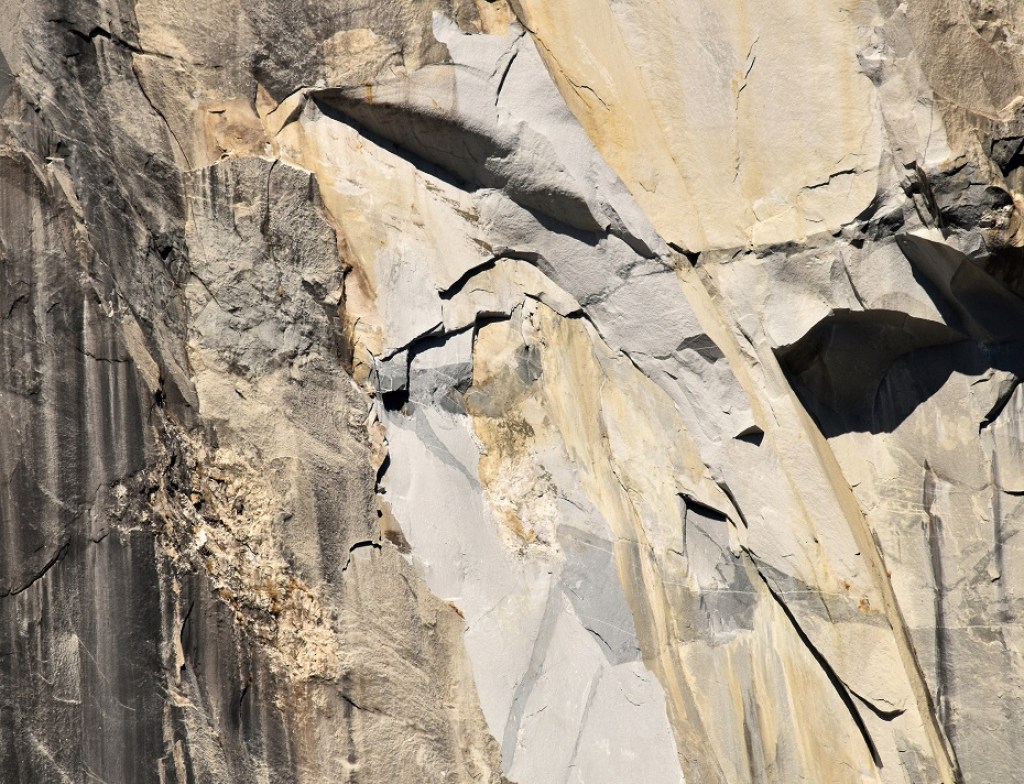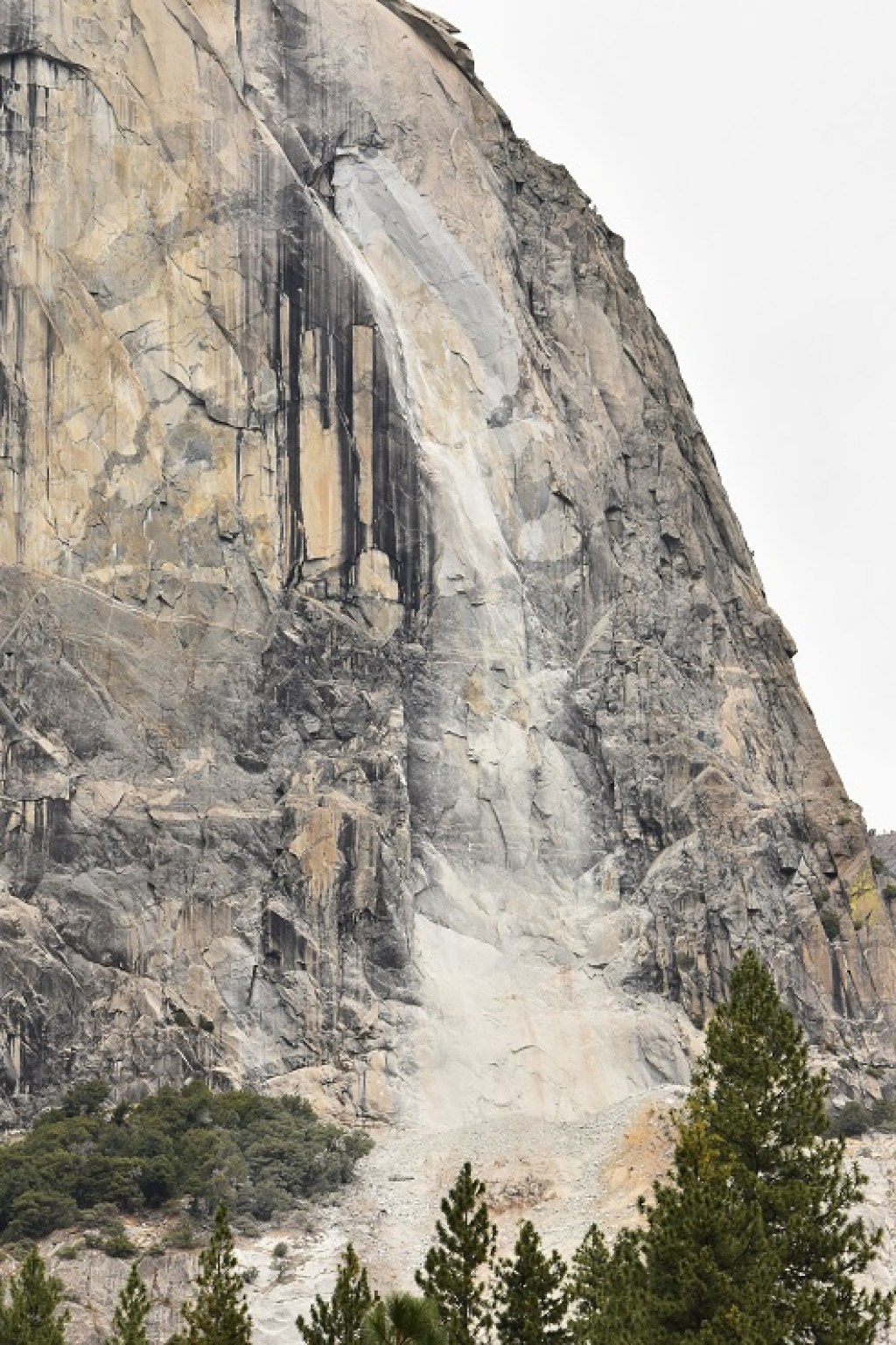Until last week, the last rockfall-related death in Yosemite was nearly two decades ago, but slides in the park are more common than you may think.
On the afternoon of September 27, the first of several rockfalls began 650 feet up El Capitan’s 1,800-foot east face in the vicinity of the Waterfall Route, killing Andrew Foster, 32, from Wales but sparing his wife Lucy Foster, whom he leaped over to shield from falling debris. Lucy, injured, was short-hauled from the base of El Cap by Yosemite Search and Rescue (YOSAR) as rocks continued to fall from the wall. Plumes of rock dust filled the air so thick it resembled ocean fog.
Six more slides occurred in the same area over the next four hours, dropping an estimated 1,300 tons of granite (a small car weighs about a ton), destroying trees and scouring a path through the talus field reaching Southside Drive far below. During this time, there were at least 30 climbers on the famed big wall.

Unstable rocks hang above gap left by previous rockfall | Photo: Tom Evans / El Cap Report
Photographer and founder of the El Cap Report, Tom Evans, described Foster’s dangerous rescue in his blog: “Above… hung the unstable rocks that would, themselves, be obliterated the next day by one of the largest rockfalls ever seen on El Cap.”
On September 28, another rockfall occurred in the same vicinity as the previous one, this time 22 times larger. Despite the magnitude of this event, only one chunk of stone made it down to the road, striking a Florida man in the head after sailing through the sunroof of his SUV. He was airlifted to a hospital in Modesto and is expected to survive.
Rockfall is actually common in the 7-mile-long Yosemite Valley, with about 80 rock falls recorded annually.
The last rockfall-related death in Yosemite was 18 years ago, on June 13, 1999, when 21-year-old Peter Terbush was struck and killed instantly. He was holding his belay stance for leader Kerry Pile, who was climbing Apron Jam (5.9) on Glacier Point Apron. Without warning, about 7,500 cubic feet, or 630 tons, of rock released from the wall 1,000 feet above them, dropping Volkswagen Bug-sized blocks. Pile was struck in the head (though he sustained only minor injuries), and his lead rope was nearly severed. Miraculously, Terbush held the belay. The third member of the team, Joe Kevin, who was on the ground, was able to run and escape without injury. The rockfall on September 28 was nearly 50 times larger than this 1999 release.
Rockfall is actually common in the 7-mile-long Yosemite Valley, with about 80 recorded annually, though death and injury are comparatively rare so rockfall isn’t often newsworthy. The National Park Service reports that roughly 10 percent of climbing-specific “fatal and near-fatal traumatic injuries” are from rockfall, on average, though most of those events involve rocks dislodged by other climbers.
In Michael Ghiglieri and Charles Farabee’s “Off the Wall: Death in Yosemite,” the two describe the park’s fatality history, which includes causes related to waterfalls, BASE jumping, getting lost, murder and falls on rock. The most common causes of death are accidental drowning and vehicle incidents. There were a total of 16 deaths in the Park in 2016 (and 5.2 million visitors).
Said Stock, who calculated the amount of debris in the September 28 fall: “This is the 29th biggest rockfall in Yosemite Valley since 1857.”
Will rockfall continue in the park? Yes. Was this rockfall abnormal? Larger than average, but not unheard of. Will events like this continue? Undoubtedly.
El Cap’s southeast face, from the Dawn Wall to the East Buttress has experienced 57 rockfalls over the past 40 years, an average of nearly one and a half every year.
During my tenure in the park (1995-2005 plus a few scattered seasons), I witnessed several rockfalls, including in 1997 when Chris McNamara, Erica Kalve and I were high on the east face of El Cap via Lost in America when giant boulders rolled off the summit (or near the summit), crashing into approximately the same area as this recent rockfall. Luckily no one was injured during that event.
El Cap’s southeast face, from the Dawn Wall to the East Buttress has experienced 57 rockfalls over the past 40 years, an average of nearly one and a half rockfalls per year on that section of El Cap. Longtime Valley local Dean Fidelman, who’s spent decades in El Cap Meadow gazing up at the giant monolith, told the Co-op Journal, “Now you look up there and you see a [large] scar right there. It could have been really nasty [killed more people.]”
In an effort to prevent rockfall related death, the park service continues to monitor active areas, including the east face of El Cap, Stock said.

The rockfall’s scar | Photo: Tom Evans / El Cap Report
One possible trigger of the September rockfall was Yosemite’s heavy winter, resulting in the Valley’s highest runoff ever. Then came periods of record-breaking heat. “There were long hot spells in Yosemite Valley, with several weeks of hot weather,” said Stock. “But, fundamentally, we do not know what the exact trigger was. We’re continuing to investigate that.” El Cap experienced another massive rockfall in early September, but it occurred all the way on the other side of the formation, on the west face. Stock believes these two events are unrelated.
“We know that rockfall can be triggered by rainstorms, freezing events and earthquakes,” he explained. “But when a rockfall happens [during] the absence of those conditions, you have to look at more subtle conditions. We know that temperature change causes exfoliating slabs of granite to expand and contract, so that could be a factor.”
Though leftover sections continue to trickle down—rock fragments and a lot of rock dust—there haven’t been any significant rockfalls in the area since the 28th.
***
Big wall climbers Peter Zabrok, Ryan Sheridan and Patrick McRedmond were high on the Waterfall Route when the first, fatal slide occurred. Fazed but committed, they continued towards the summit.
The team topped out during the second, larger rockfall, and we caught up with Zabrok over the phone shortly after. “I’m a little bit shaken up,” he said. “I’m a little wobbly. I’m in beautiful Camp 4 in the sunshine now, but I can’t help but feel a little bit of PTSD.”
